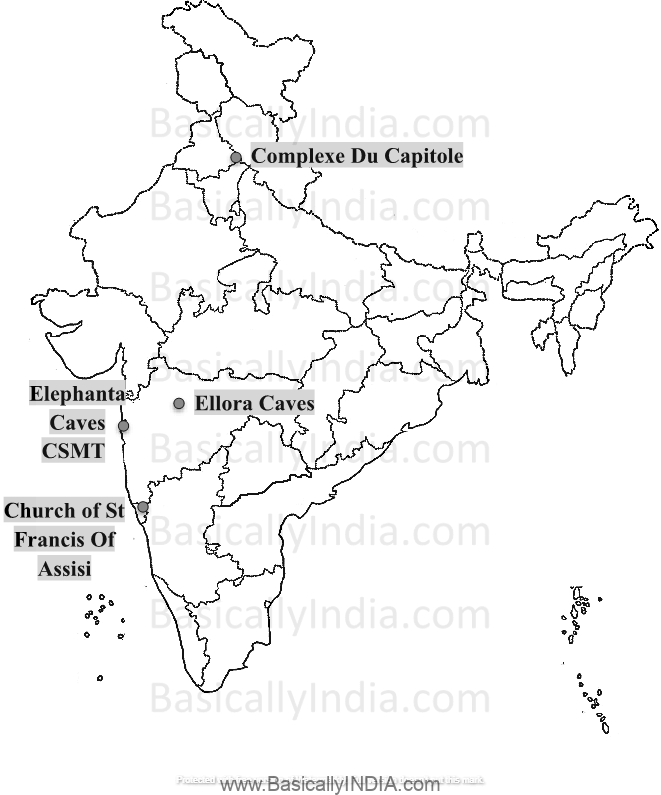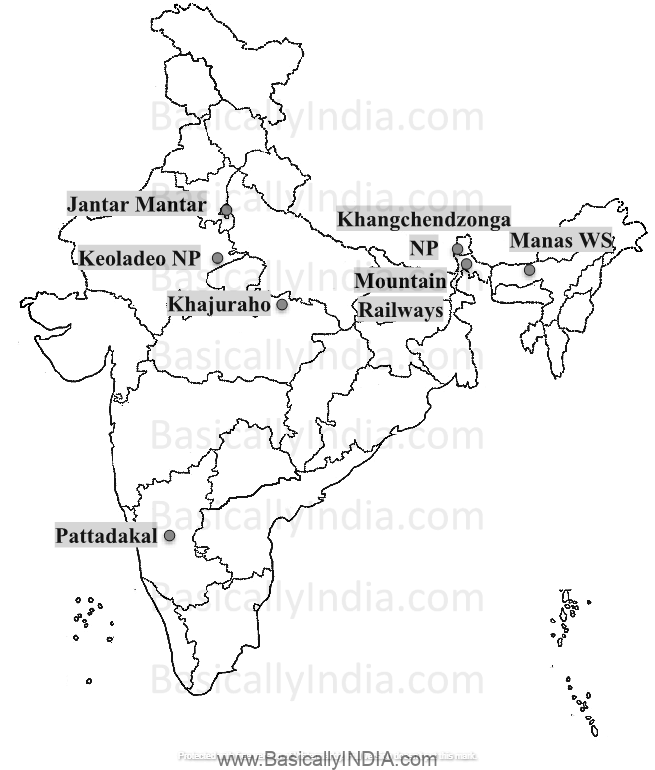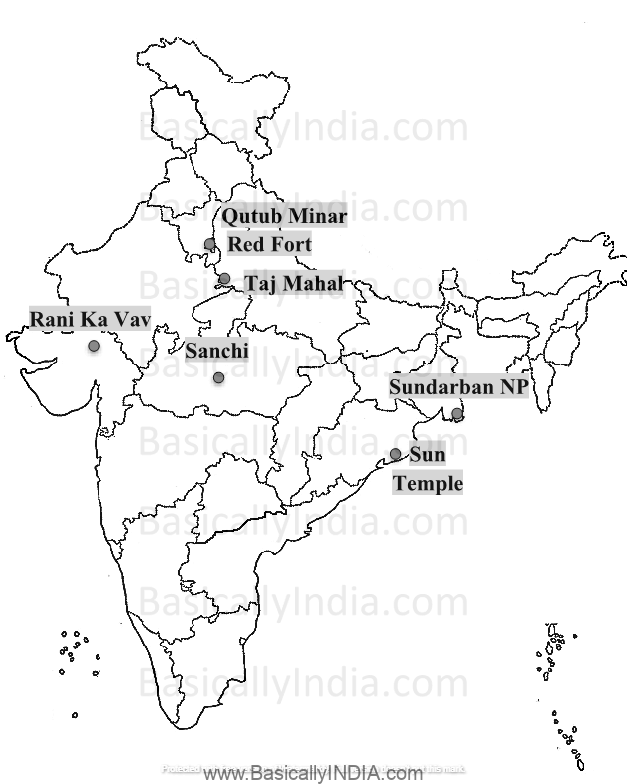
1. Agra Fort
• Built by Mughal emperor Akbar in 1565 AD.
• In the bank of River Yamuna
• Shah Jahan added most of the marble monuments
• Include Moti Masjid, Diwan-i-Khas (hall of private audience) and Diwan-i-Aam (hall of public audience)
2. Ahmedabad
• India’s first UNESCO World Heritage City
• Earlier known as Karnavati
• Divided into two parts by the Sabarmati river
• Famous for grand and larger-than-life celebrations during Navratri
3. Ajanta Caves
• Located 107 km from Aurangabad
• Famous for a cluster of 32 Buddhist caves having chaityas and viharas.
• Chaityas caves 9 and 10 contain the earliest known remnants of paintings in India
• Depict of Jataka tales found
4. Bhimbetka Prehistoric Rock Shelters
• Located 45km south of Bhopal
• Discovered by VS Wakankar in 1957
• Paintings created with natural colours have withstood the test of time
• Scenes of horse and elephant riding, honey collection, food hunting, dancing etc., can be seen
5. Bodh Gaya
• Located in Bihar
• Here Lord Buddha attained nirvana (enlightenment) under Bodhi tree
• Also has significance in Hinduism as offering to ancestors
6. Champaner Pavagadh Archaeological Park
• Located in Panchmahal district of Gujarat
• In Pavagadh Hills and extend into Champaner city
• Islamic pre-Mughal city
• Has a large number of Hindu and Jain temples as well as mosques

7. Chhatrapati Shivaji Maharaj Terminal (CSMT)
• Located in Mumbai
• Finest railway stations in the world with a footfall of over 3 million daily
• Was named Victoria Terminus in honor of British Queen Victoria
• To mark fifty years of her reign on Golden Jubilee Day (1887)
• Designed by British architect F W Stevens
8. Church of St Francis Of Assisi
• Located in the main square of Old Goa, 10 km from the capital city Panaji
• Established by eight Franciscan friars who arrived in Goa in 1517
• Portuguese-Manueline styled built-in 1661
9. Complexe Du Capitole
• Located in sector-1 of Chandigarh near Shivalik range
• Designed by the architect Le Corbusier
• The Secretariat, the High Court and the Legislative Assembly located in it
10. Elephanta Caves
• Lies near Gateway of India, in Colaba in the Elephanta Island known as Gharapuri or the Fortress City
• Home to a network of ancient rock-cut caves, artistic wall carvings and sculptures of Hindu, Buddhist and Pashupati sect of the Shaiva system.
• Gun Hill and Stupa Hill lies in the island
• 7-m-high sculpture of Sadashiva is at the entrance of the cave
11. Ellora Caves
• Located in Aurangabad
• Comprises of 34 Hindu, 17 Buddhist and 5 Jain caves
• Chiselled between the 4th and the 9th century
• Buddhist caves have images of Lord Buddha and bodhisattvas.
• Have up to three-storeyed caves
• Hindu Caves were excavated during the rule of the Kalachuri, Chalukya and Rashtrakuta rulers
• Jain caves have the largest number of wall paintings on extant ceilings

12. Fatehpur Sikri
• Capital of Mughal emperor Akbar between 1572 and 1585 AD
• Constructed using red sandstone
• Akbar built Buland Darwaza here after capturing Gujarat
• Tomb of Salim Chishti, Diwan-i-Khas, Mariyam’s Tomb, Birbal’s Palace and Panch Mahal (a four-storeyed columnar structure to listen Tansen) lies in it
13. Great Himalayan National Park
• Located in Himachal Pradesh
• Home of threatened species of mammals – snow leopard, serow, the Himalayan tahr and musk deer and threatened bird species -Western tragopan, koklass, cheer pheasants
14. Hampi
• Located in Karnataka
• Built under Vijayanagara empire (1336 – 1646 AD) on the banks of the Tungabhadra river
• The wedding place of Lord Shiva and Goddess Parvati
• Queen’s bath and Lotus Palace are major attraction
15. Hill Forts of Rajasthan
• Amber Fort, Chittorgarh Fort, Gagron Fort, Jaisalmer Fort, Kumbhalgarh Fort, Ranthambore Fort etc tell the glory, beauty and heritage of Rajasthan
16. Humayun’s Tomb
• Located near Hazrat Nizamuddin Dargah in Delhi
• Built by empress Haji Begum in memory of her husband Mughal emperor Humayun
• Designed by Persian architect Mirak Mirza Ghiyas
17. Jaipur
• Founded by Maharaja Jai Singh II in 1727 AD
• Known as Pink City is the capital of Rajasthan
• Famous for Hawa Mahal and Amber Fort
18. Kaziranga
• Located in Assam
• Home to two-thirds of the world’s population of one-horned rhinoceros.
• Also lies Deoparbat Hill and Kakochang Waterfall

19. Jantar Mantar
• Astronomical observatories built by Maharaja Sawai Jai Singh II
• Located in Jaipur, Delhi, Varanasi and Ujjain
20. Keoladeo National Park
• Located in Bharatpur, Rajasthan
• Famous for birdwatching and ecotourism
21. Khajuraho Group of Monuments
• Has about 25 temples spread over an area of 6 sq km
• Temples of Lord Shiva, Lord Ganesha, Sun God and Jain Tirthankaras
• Kandariya Mahadeva Temple, dedicated to Lord Shiva is the largest temple.
• Jain temples are of Adinath, Shantinath, Parsvanath and Ghantai, constructed under the reign of Chandela rulers
22. Khangchendzonga National Park
• Located in Sikkim
• Famous for snow leopard, red panda, great Tibetan sheep, musk deer etc.
23. Manas Wildlife Sanctuary
• Located in Assam
• Home of Indian rhinoceros, Indian elephant, tiger, pygmy hog, golden langurs, bison, deer, red panda etc.
24. Mountain Railways of India
• Darjeeling Himalayan Railway (DHR) popularly known as the toy train, was started in 1881
• 87 km route in the hills and the dense forests runs between New Jalpaiguri and Darjeeling
25. Pattadakal
• Series of nine Hindu temples, built by Early Chalukyas (543-753 CE)
• Dedicated to Lord Shiva and Lord Vishnu
• On the banks of River Malaprabha that flows into River Krishna
• Virupaksha Temple built by Queen Lokamahadevi in c. 740 is the most famous one, marks King Vikramaditya II victory over the Pallavas
• Mallikarjuna, Sangameswar, Kadasiddheswar, Papanatha Galaganath, Chandrashekhar etc are other Temples

26. Qutub Minar
• Located in Delhi
• 73-foot-tall is a five-storeyed tower
• First three storeys are built in red sandstone while the fourth and fifth are made of marble and sandstone.
• Started by Qutub-ud-din Aibak, of Mamluk dynasty (1206-1290 and completed by Iltutmish and Firoz Shah Tughlaq
27. Rani Ki Vav
• Located in Gujarat on the banks of Saraswati river
• Constructed by Rani Udayamati in the memory of her husband, king Bhima I, of the Chaulukya -Solanki dynasty (950-1300 CE).
• Stepwell depicting religious, mythological and secular imagery
28. Red Fort
• Built by Mughal emperor Shah Jahan in Old Delhi
• Fusion of Islamic, Persian, Timurid and Hindu styles
• Fort was invaded by Nadir Shah in 1739
• PM of India hoists National Flag from the ramparts of the Lahore Gate every year on Independence Day,
29. Sanchi
• Located in Madhya Pradesh
• Stupas build by Ashoka to safeguard the Buddhist relics
• Further elaborated in Andhra-Satavahanas and Gupta periods
30. Sun-Temple
• Located in Konark, Odisha near Bay of Bengal coastline
• Built-in 13th century by Ganga king Narasimhadeva I, is the torchbearer of Kalinga architecture
31. Sundarbans National Park
• Located on the coastline of West Bengal
• Home to the royal Bengal tiger
• Named after mangrove plant called ‘Sundari’
32. Taj Mahal
• Built by Shah Jahan in memory of his wife Mumtaz Mahal
• On banks of Yamuna river in Agra UP
• Chief of the project was Ustad Ahmad Lahori, site planed by Ustad Isa and calligraphic work was by Amanat Ali Khan Shirazi

33. Valley of Flowers and Nanda Devi National Park
• Located in Uttarakhand
• Along Zanskar range at an altitude of around 11,000 ft
• In August and September flowers are in full bloom
34. Victorian Gothic and Art Deco
• Located in Mumbai
• About 94 buildings stand along the Arabian sea and beside Oval Maidan
• Hosts the Bombay High Court, University Library and Convention Hall, David Sasoon Library, PWD Office, Watson’s Hotel, Elphinstone College, etc.
35. Western Ghats- Ooty
• Runs along the western coast of India through Kerala, Karnataka, Tamil Nadu and Maharashtra
• From Tapti river in the north to the southern tip of India
• Cardamom Hills, Nilgiris, Anaimalai Hills and Sahyadris are located in it.
• Rich in biodiversity and ecotourism with several national parks and wildlife sanctuaries
36. Mamallapuram (Mahabalipuram)
• Located in Tamil Nadu on Coromandel Coast
• Built during Pallava dynasty (3rd – 9th century BC)
• Krishna’s Butter Ball, The Panch Rath, Shore Temple
37. Nalanda
• Located in Bihar
• Greatest education institute during 5th to 12th Century CE
• Prominent Buddhist centre
• Chinese traveller Hieun Tsang visited Nalanda in the 7th century
38. Thanjavur
• Located in Tanjore, Tamil Nadu
• Developed during the Chola Empire
• Brihadeeswarar Temple is of the 11th century
• Birthplace of ‘thavil’ musical instrument
• Popular for classical music and Bharatnatyam dance

Pingback: Waterfalls -
Pingback: Peaks -
Pingback: Coast Line -
Pingback: Lakes - 21 Most Spectacular Lakes in India
Pingback: Biosphere Reserves -
Pingback: National Parks & Wildlife -
Pingback: Rivers -
Pingback: Oilfields -